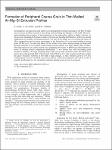Search
Author
- Goik, P. (1)
- Höppel, H. W. (1)
- Ludwig, Andreas (1)
- Mogeritsch, Johann (1)
- next >
Subject
Date issued
- 2023 (2)
Has File(s)
- true (2)
Search Results
Investigations on microstructure and texture development during processing of Al–Mg–Si sheet and extrusion profiles focused on describing and modelling the changes in the bulk. However, understanding the evolution of microstructure in the sub-surface region is highly relevant, as this governs material performance under corrosion and bending deformation, which are crucial applications in mobility and transportation. The aim of this study was to correlate the effect of alloy composition and extrusion parameters to the formation of texture and peripheral coarse grain (PCG) layer. For this, five alloys of the AA6xxx class with varying content of dispersoid forming elements were extruded at increasing extrusion speeds into thin-walled hollow profiles. The microstructure at a plane sectio... |
Herein, in a microgravity campaign onboard the International Space Station, peritectic coupled growth (PCG) is studied by solidifying alloys of the peritectic transparent organic system TRIS–NPG under purely diffusive conditions. The experiment reveals that the formation of PCG begins with coagulated lateral bands comprising the peritectic phase at temperatures below the peritectic one. After reaching the growth front of the pro-peritectic phase, growth competition between both solid phases occurs such that the patches of the pro-peritectic phase, lamellae, and fibers/rods grow in the stated order, coupled with the peritectic phase. As the entire solidification process occurs during the initial transient stage, the diffusion coupling between the two solid phases is weak. |


